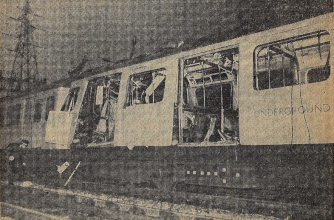
The West Ham station attack is a bombing and shooting attack at West Ham station in east London on March 15, 1976. One person dies in the attack and nine are injured.
A 5-lb. (2.3 kg) bomb on a Metropolitan line train explodes prematurely in the front carriage of the train, injuring seven passengers. The bomb detonates prior to reaching the City of London, where it is thought the intended target to be Liverpool Street station at rush hour. Adrian Vincent Donnelly, a Provisional Irish Republican Army (IRA) volunteer, then shoots Post Office engineer Peter Chalk in the chest, and kills train driver Julius Stephen, who had attempted to catch him. Donelly exits the station to the street and threatens people with his revolver before Police Constable Raymond Kiff catches up with him. Shouting “You English bastards!” Donelly shoots himself in the chest but survives and is apprehended by Kiff.
Adrian Donelly, 36 at the time, is originally from Castlefin, County Donegal, in the Republic of Ireland but lives in London from 1971. He is part of an active service unit (ASU) involved in planting sixteen bombs. In 1977, at the Old Bailey, he is convicted of murder and attempted murder. He is sentenced to life imprisonment by Justice David Croom-Johnson with a minimum of 30 years. He is released after 21 years in August 1998 as one of the earliest beneficiaries of the Good Friday Agreement‘s prisoner release scheme. He dies on August 25, 2019.
Eleven days prior to the West Ham station attack, an IRA bomb explodes in a train at Cannon Street station. The day after the West Ham attack, a bomb on a train at Wood Green tube station explodes, injuring a man. On March 17, a 9-lb. (4.1 kg) bomb is discovered in a train at Neasden Depot. After these events, the London Transport Executive launches a security operation and assigns 1,000 plainclothed policemen on the London Underground system.
An appeal to raise money is launched for the family of the driver of the train, Julius Stephen, who left behind a widow and a family. As of August 1976, £17,000 had been raised.
(Pictured: The underground train damaged in the explosion, The Times, March 16, 1976)
